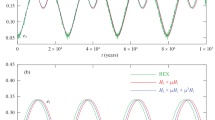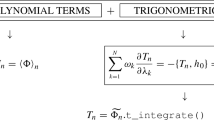Abstract
-
1.
The short-period terms of a second-order general planetary theory are removed through the Hori's method based on a development of the HamiltonianF in a Lie series which involves a determining functionS not depending upon mixed canonical variables as in the Von Zeipel's method but upon all the canonical variables resulting from the elimination of the short period terms ofF. Canonical variables adopted are the slow Delaunay variables. Eccentricitiese j and sines γj of the semi inclinations are respectively replaced by the Jacques Henrard variablesE j ,J j which lead to formulas remarkably simple.F is reduced to the sumF 0+F 1 of its terms of degrees 0,1 in small parameter ε of the order of the masses. Only one disturbing planet is considered.F 1 is not calculated beyond its terms of degree 3 inE j ,E j ,J j , the determining functionS 2 of degree 2 in ε not being therefore calculated beyond its terms of degree 2 inE′ j ,E j ,J j and the expressions of slow Delaunay canonical variables of the disturbed planetP 1 and the disturbing planetP 2 in terms of the new slow Delaunay canonical variables ofP 1 andP 2 which result from the elimination of the short period terms ofF 1 being therefore reduced to their terms of degree <1 in theE′ j ,E′ j ,J′ j . Calculation of the principal partF 1m ofF 1 is carried out through Laplace coefficients and operatorD=α(d/dα) applied to Laplace coefficients, α ratio of the semi major axis ofP 1 andP 2. Eccentricitye 2 of the disturbed planetP 2 is assumed to be zero, such an assumption not restricting our aim which is to investigate the mechanism of the elimination of short period terms in a second order general planetary theory carried out through the Hori's method, not to perform the elimination of those terms for a complete second order general planetary theory. Expressions of the slow Delaunay canonical variables in terms of the new ones resulting from the elimination of the short period terms ofF 1 are written down only for the disturbed planetP 1.
-
2.
Small divisors in 1/E′ 1 and 1/E′ 21 appear in the longitude ϖ1 of perihelia ofP 1. No small divisors appear in the other five slow Delaunay variables ofP 1. The only Jacques Henrard variables which appear in the longitude Ω1 of the ascending node ofP 1 are the J j′ j=1, 2 and no Jacques Henrard variables appear in the slow Delaunay canonical variablesX 1,Y 1,Z 1, λ1. The solving of the ten canonical equations ofP 1 andP 2 in the slow Delaunay canonical variablesX′ j ,Y′ 1,Z′ j ,λ′ j ,ω′ j ,Ω′ j resulting from the elimination of the short period terms ofF 1 reduces to that of four canonical equations inZ′ j ,©′ j and to six quadratures three of them expressing theX′ j ,Y′ 1 are constants and the three others expressingλ′ j ,ϖ′ j as functions of timet. Solving of the four canonical equations inZ′ j ,Ω′ j reduces to that of a first order non linear differential equation and to two quadratures. Sinceγ′ 1 is then constant, so is the Jacques Henrard variableE′ 1. If the eccentricitye 2 ofP 2 is no more assumed to be zero, additive small divisors inE′ 2/E′ 2 1 appear in longitude ϖ′1 of perihelia ofP 1 and the solving of the twelve canonical equations ofP 1 andP 2 inX′ j ,Y′ j ,Z′ j ,λ′ j ,ϖ′ j ,Ω′ j is reduced to that of eight canonical equations inY′ j ,ϖ′ j ,Z′ j ,Ω′ j and to four quadratures expressingX′ j are constants andλ′ j as functions oft. Those eight canonical equations split into two systems of four canonical equations, one of them inY′ j ,ϖ′ j and the other one inZ′ j ,Ω′ j . Each of those two systems is identical to the system inZ′ j ,Ω′ j corresponding toe 2=0 and its solving reduces to that of a first order non linear differential equation and to two quadratures identical to those of the casee 2=0.
-
3.
Expressions ofX 1,Y 1,Z 1,λ 1,ϖ 1,Ω 1 as functions ofX′ j ,Y′ 1,Z′ j ,λ′ j ,ϖ′ 1,Ω′ j ;j=1, 2 are sums of sines and cosines of the multiples ofλ′ j ,ϖ′ 1,Ω′ j for the terms arising from the indirect partF 1j ofF 1, Fourier series in those sines and cosines or products of two such Fourier series for the terms arising from the principal partF 1m ofF 1, coefficients of those sums and Fourier series having one of the eight forms:
$$A,{\text{ }}\frac{B}{{E'}},{\text{ }}\frac{C}{{E'^2 }},{\text{ }}D\frac{{j'^{2_1 } }}{{E'^{2_1 } }},{\text{ }}E\frac{{j'^{2_2 } }}{{E'^{2_1 } }},{\text{ }}F\frac{{j'^{_1 } j'^2 }}{{E'^{2_1 } }},{\text{ }}G\frac{{j'^2 }}{{j'^{_1 } }},{\text{ }}H\frac{{j'^{22} }}{{j'^{2_1 } }}{\text{.}}$$A,..., H being constants which depend upon ratio α. Numerical calculation of the constantsA,..., H arising from the terms ofF 1j is easily carried out; that of theA,..., H arising from the terms ofF 1m require more manipulations, Fourier series in sines and cosines of the multiples ofλ′ j ,ϖ′ j ,Ω ij and products of two such Fourier series having then to be reduced to sums of a finite number of terms and treated through the methods of harmonic analysis. Divisors inp+qα3/2;p, q relative integers, or products of such divisors appear inA,..., H.
-
4.
the method extends to the case whenF 1 is calculated beyond its terms of degree 3 in the Jacques Henrard variables.F 1 being calculated up to its terms of degree 8 in the Jacques Henrard variables which is the precision required to eliminate the short period terms of a complete second order general planetary theory,S 2 has to be calculated up to its terms of degree 7 and the expression of the slow Delaunay canonical variables ofP 1 andP 2 in terms of the slow Delaunay canonical variables ofP 1 andP 2 resulting from the elimination of the short period terms ofF 1 have, therefore, to be calculated up to their terms of degree 5 in the Jacques Henrard variables.
Similar content being viewed by others
References
Brouwer, D.: 1959,Astron. J. 64, 378–397.
Brown, E. W. and Shook, C. A.: 1933,Planetary Theory, Cambridge Univ. Press.
Deprit, A., Henrard, J., and Rom, A.: 1970, Document D1-82-0990, Boeing Sci. Res. Laboratories, Seattle, Wash., U.S.A.
Hori, G. I.: 1966,Publ. Astron. Soc. Japan 18, 287–295.
Meffroy, J.: 1966a, Special Rpt. No. 299,Smithson. Astrophys. Obs., Cambridge, Mass, U.S.A.
Meffroy, J.: 1966b,Compt. Rend. Acad. Sci. Paris 263, 145–148.
Meffroy, J.: 1967, Document X-641-67-318, NASA Goddard Space Flight Center, Greenbelt, Md., U.S.A.
Author information
Authors and Affiliations
Rights and permissions
About this article
Cite this article
Meffroy, J. On the elimination of short-period terms in second-order general planetary theory investigated by Hori's method. Astrophys Space Sci 25, 271–354 (1973). https://doi.org/10.1007/BF00649176
Received:
Issue Date:
DOI: https://doi.org/10.1007/BF00649176




